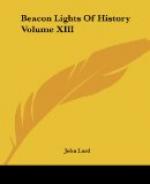The sentimental metrical romance “Maud” appeared in 1855 (the year of the Crimean War), with some additional poems, including ’The Charge of the Light Brigade,’ written after Raglan’s repulse of the Russians at Balaclava, and the fine ‘Ode on the Death of the Duke of Wellington.’ The lyrical love-drama, “Maud,” we are told, was one of Tennyson’s favorite productions, of which he was wont to read parts to his guests. As the poet has himself said of the monodrama, “it is a little Hamlet,” “the history of a morbid poetic soul, under the blighting influence of a recklessly speculative age. He is the heir of madness, an egotist with the makings of a cynic, raised to sanity by a pure and holy love which elevates his whole nature, passing from the heights of triumph to the lowest depths of misery, driven into madness by the loss of her whom he has loved, and when he has at length passed through the fiery furnace, and has recovered his reason, giving himself up to work for the good of mankind through the unselfishness born of his great passion.” The poem, when it appeared, was reviled by some critics as an allegory of the war with Russia, and they did its author the injustice of supposing that he lauded war for war’s sake, instead of, as is the case, applauding war only in defence of liberty. Apart from this misunderstanding, due to abhorrence of the war-frenzy of the period, the poem has outlived the mistaken objections to it when it appeared, and is now admired in its vindicated light, and especially for the rich and copious beauty manifest throughout the work, and for the magnificent lyric art with which it is composed.
We now come to Tennyson’s masterpiece, the “Idylls of the King,” an epic of chivalry, interpreted as personifying in its various characters the soul at war with the senses. These appeared during the years 1859 and 1872. Each of the Idylls, which has a connecting thread binding it to its fellow-allegory, takes its plot or fable from the legendary lore that has clustered round the name of Arthur, mythical King of the Britons about the era of the first invasion by the English. Out of the mass of material which was gathered by Sir Thomas Malory for his prose history of Arthur and his Knights, Tennyson takes the chief incidents and noblest heroic traits of character in the legends and blends them in a fashion of his own, steeping them in an atmosphere which his imagination creates, and lighting up all with a passion and glory of knightly adventure, as well as with a chasteness, purity, and high fervor of ethical thought, that must perpetuate the romance, as he has given it us, unto all time. The sections of the work as it now stands, in addition to its introductory dedication to the late Prince Consort, and the closing poem to the late Queen Victoria, are as follows: ’The Coming of Arthur,’ which relates the mystery of the birth of the King, his marriage to Guinevere, daughter of Leodogran, King of Cameliard, and the wonders attending




